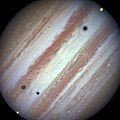File:Galilean satellite triple conjunction 2015-01-24 (right).jpg

Original file (1,000 × 1,000 pixels, file size: 584 KB, MIME type: image/jpeg)
| This is a file from the Wikimedia Commons. Information from its description page there is shown below. Commons is a freely licensed media file repository. You can help. |
Summary
| DescriptionGalilean satellite triple conjunction 2015-01-24 (right).jpg |
English: Firing off a string of snapshots like a sports photographer at a NASCAR race, NASA's Hubble Space Telescope captured a rare look at three of Jupiter's largest moons parading across the banded face of the gas-giant planet: Europa, Callisto, and Io.
These so-called Galilean satellites (named after the 17th century scientist Galileo Galilei, who discovered them with a telescope) complete orbits around Jupiter ranging from 2 days to 17 days in duration. They can commonly be seen transiting the face of Jupiter and casting shadows onto its cloud tops. However, seeing three moons transiting the face of Jupiter at the same time is rare, occurring only once or twice a decade. The Hubble image on the left shows the beginning of the event, which took place on January 24, 2015. From left to right the moons Callisto and Io are above Jupiter's cloud tops. The shadows from Europa (not seen in the image), Callisto, and Io are strung out from left to right. Near the end of the event, approximately 42 minutes later (right-side image), Europa has entered the frame at lower left. Slower-moving Callisto is above and to the right of Europa. Fastest-moving Io is approaching the eastern limb of the planet; its shadow is no longer visible on Jupiter. Europa's shadow is toward the left side of the image, and Callisto's shadow to the right. (The moons' orbital velocities are proportionally slower with increasing distance from the planet.) Missing from the sequence is the moon Ganymede, which was outside Hubble's field of view and too far from Jupiter in angular separation to be considered part of the conjunction. The moons in these photos have distinctive colors. The ancient, cratered surface of Callisto is brownish; the smooth icy surface of Europa is yellow-white; and the volcanic, sulfur-dioxide surface of Io is orange. The apparent "fuzziness" of some of the shadows depends on the moons' distances from Jupiter. The farther away a moon is from the planet, the softer the shadow, because the shadow is more spread out across the disk. The images were taken with Hubble's Wide Field Camera 3 in visible light. |
|||
| Date | (released 5 February 2015) | |||
| Source | http://hubblesite.org/newscenter/archive/releases/2015/05/image/b/ and http://hubblesite.org/newscenter/archive/releases/2015/05/image/c/ (see also http://heritage.stsci.edu/2015/05/index.html) | |||
| Author | NASA, ESA, and the Hubble Heritage Team (STScI/AURA) | |||
| Other versions |
|
Licensing
| Public domainPublic domainfalsefalse |
| This file is in the public domain in the United States because it was solely created by NASA. NASA copyright policy states that "NASA material is not protected by copyright unless noted". (See Template:PD-USGov, NASA copyright policy page or JPL Image Use Policy.) |  | |
 |
Warnings:
|
Captions
In dieser Datei abgebildete Objekte
depicts
File history
Click on a date/time to view the file as it appeared at that time.
| Date/Time | Thumbnail | Dimensions | User | Comment | |
|---|---|---|---|---|---|
| current | 17:02, 19 February 2021 |  | 1,000 × 1,000 (584 KB) | Charlestpt | File:Galilean satellite triple conjunction 2015-01-24.jpg cropped 50 % horizontally using CropTool with lossless mode. |
File usage
The following page uses this file:
Global file usage
The following other wikis use this file:
- Usage on fr.wikipedia.org
Metadata
This file contains additional information, probably added from the digital camera or scanner used to create or digitize it.
If the file has been modified from its original state, some details may not fully reflect the modified file.
| Width | 1,000 px |
|---|---|
| Height | 1,000 px |
| Bits per component |
|
| Compression scheme | LZW |
| Pixel composition | RGB |
| Orientation | Normal |
| Number of components | 3 |
| Horizontal resolution | 72 dpi |
| Vertical resolution | 72 dpi |
| Data arrangement | chunky format |
| Software used | Adobe Photoshop Elements 12.0 Macintosh |
| File change date and time | 12:31, 7 February 2015 |
| Exif version | 2.21 |
| Color space | sRGB |
| Date metadata was last modified | 04:31, 7 February 2015 |
| Date and time of digitizing | 04:26, 7 February 2015 |
| Unique ID of original document | xmp.did:767D3918392068118083DF440090DADA |

